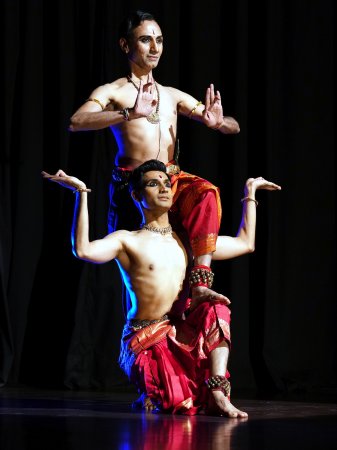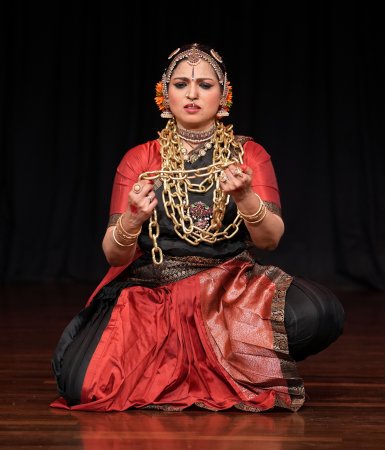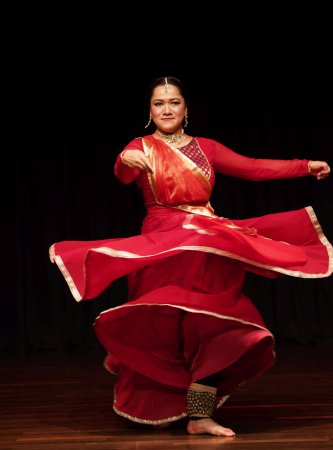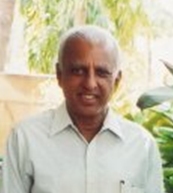
|   |

|   |
Rhythms in harmony - Satish Suri e-mail: satishism@yahoo.co.in Photos: Prof K.S.Krishnamurthy May 13, 2025 DUAL MARGAM In an inspired evening of classical confluence, the Bangalore International Centre played host on the 10th of April to a distinctive Dual Margam performance that celebrated the vibrant diversity of Indian classical dance. Curated with discernment by Sahana Das, the program brought together two highly accomplished artistes - Praveen Kumar, an exponent of Bharatanatyam known for his elegance and emotive restraint, and Avijit Das, a rising Kuchipudi virtuoso whose theatrical flair and effervescent energy are steadily drawing national attention.  Praveen Kumar and Avijit Das The concept of a Dual Margam - where two dancers present individual traditional repertoires while also exploring shared choreographic moments - allowed for a compelling interplay of styles, aesthetics, and philosophies. The performance opened with a specially commissioned Jatiswaram set to a composition in Shankarabharanam raga by Mahesh Swamy, offering a glimpse into both dancers' technical command. Executed with remarkable precision and symmetry, the piece emphasised the purity of nritta, allowing rhythmic patterns to unfold with clarity and flair. The choreography was deftly structured to reflect the innate grammar of both forms while letting the dancers imprint their individuality within the common frame. In his solo, Praveen Kumar chose "Va va Velava", a lyrical piece composed by Papanasam Sivan, in which Lord Muruga is visualised in an endearing domestic tableau - seated on his mother's lap, flanked by his consorts Valli and Devayani. Praveen's strength lies in his quiet intensity. Through measured expression, fluid transitions, and subtle glances, he invoked the child god's charm with an understated dignity, drawing the viewer into a world of devotional intimacy. His abhinaya was particularly poignant, suggesting the divine presence and the emotional atmosphere surrounding it. Avijit Das, in contrast, offered a dynamic solo in "Brahmam Okkate", a well-known philosophical text that affirms the oneness of all creation. His interpretation of the Kuchipudi idiom was marked by vibrant footwork, expressive clarity, and creative use of space. Avijit's ability to oscillate between theatrical expansiveness and contemplative stillness brought fresh depth to the piece. His delivery blended exuberance with gravitas, reminding the audience that Kuchipudi is as much about philosophical communication as it is about physical virtuosity. The duo's exposition of "Jagadodharana", another gem from the Purandaradasa canon, became the emotional centrepiece of the evening. In this shared canvas, the two dancers engaged in an affectionate artistic dialogue, evoking the tender vatsalya bhava of Yashoda playing with young Krishna. What emerged was a joyous, almost competitive delight, as each artiste embodied maternal devotion through their respective vocabularies - the angular precision of Bharatanatyam and the lyrical fluidity of Kuchipudi. It was in this piece that the thematic intent of the evening - harmony through contrast - was most vividly realised. The performance concluded with a spirited Thillana, where both dancers returned to pure dance with infectious energy. Here, the contrast in body language - Bharatanatyam's sculptural sharpness meeting Kuchipudi's spring-loaded buoyancy, added a layer of visual dynamism. Their verve and virtuosity in executing complex rhythmic sequences left the audience visibly uplifted, marking a rousing close to an already memorable evening. The live music ensemble played a pivotal role in shaping the performance's emotive and rhythmic landscape. Navyashree K.N. on nattuvangam, R. Raghuram on vocal, Vinay Nagarajan on the mridangam, and Mahesh Swamy on the flute created an evocative aural backdrop that enriched the dancers' expressions. The lighting design by Manju Madkeri subtly enhanced the mood and visual architecture, lending the performance a layered theatricality. MANO MANTHANA: A SPIRITUAL CHURNING IN MOVEMENT AND MUSIC Srividya Angara Sinha's "Mano Manthana" was not merely a dance performance-it was a deeply contemplative spiritual journey, articulated through the evocative medium of Kuchipudi at the Bangalore International Centre on the 15th of April. Drawing from the rich etymology of its title," Mano Manthana"- a churning (manthana) of the mind (mano)-the production invited the audience to witness the dancer's inner voyage, where the soul wrestles with existential dilemmas, emotional entanglements, and a yearning for the Absolute.  Srividya Angara Srividya constructed a narrative that explored the turbulence of the human condition, constantly oscillating between the constraints of corporeality and the soul's aspirational longing for transcendence. The production raised profound philosophical questions: Where does the search for the divine truly begin? Is there an end? And what intensity of devotion suffices in bridging the mortal with the eternal? These inquiries formed the substratum of a performance that was at once intensely personal and universally resonant. Anchored in the evocative compositions of Saint Tyagaraja, each piece served as a milestone in the protagonist's spiritual evolution. The performance commenced with "Raghunayaka", brimming with bhakti rasa, where the dancer celebrated the divine presence in all its majesty. There was an infectious joy as she extolled the beauty of the "fully blossomed lotuses" of the Lord's feet-a metaphor that echoed spiritual surrender. This effulgence gradually gave way to a more introspective tone in "Paraloka sadhaname". Here, Srividya used the stark imagery of chains to embody the karmic bonds and inner constraints that tether the soul. The choreography emphasised moments of resistance and yearning, with gestures that seemed to push against invisible boundaries. A disembodied voice urged the seeker forward, while the protagonist, in a moment of vulnerability, asked, "I am so full of attributes, is there hope?"- an honest, soul-searching cry that resonated with every seeker in the audience. The turning point came with "Dugukula", where the act of chanting became a meditative refuge, illustrating the power of naama japa to cleanse and centre the being. In "Nagumomu ganaleni", the dancer captured the paradox of spiritual unawareness despite divine omnipresence. Her expressions conveyed an aching desire to perceive the divine as if blinded by the veils of samsara. In "Enduku dayaradura" (Todi), Srividya's rendition reached an emotional crescendo. Here, the protagonist's anguish transformed into an impassioned plea-almost accusatory-demanding why the Divine had remained elusive amidst her trials. This segment was rendered with raw emotive intensity, her abhinaya evoking both fury and desperation. The denouement unfolded with "Jagadhanandakaraka", symbolising the moment of realisation-the seeker recognises the divine not as a distant entity, but as an indwelling presence. The earlier restlessness dissolved into bliss in "Sogasu chuda tharama", where the protagonist celebrated the ineffable beauty of the divine. The concluding "Kanugonti Sree Rama" emerged as an affirmation of spiritual fulfilment-a joyous union where the dance became prayer, and the stage, a sanctum. Throughout, Srividya Angara Sinha demonstrated an enviable command over her medium. Her choreography was layered with meaning, balancing traditional Kuchipudi vocabulary with contemporary dramaturgical sensitivity. Her expressive range-anchored in subtle abhinaya and supported by precise nritta-allowed the narrative to breathe, expand, and transform. Symbolism played a vital role, with minimal but potent use of props-most notably the chains in "Paraloka sadhaname"-which served as tangible extensions of the internal conflict. Lighting and sound design were unobtrusive yet effective, heightening the mood without overshadowing the performance. The music, on a recorded track, enriched by Ranjani Sivakumar Siddareddy's soulful vocals, G Gurumurthy's rhythmic mridangam, D V Prasanna Kumar's precise nattuvangam, Jayaram Kikkeri's evocative flute, Pradesh Achar's stirring violin, Somashekhar Jois' dynamic konnakkol, and Akash Parva's atmospheric keyboard and effects, created a vibrant sonic tapestry. RAKHTABHA The Kathak production, performed by Aishwarya Verma, on the 23rd of April at the Bangalore International Centre, unfolded as a mesmerising journey through four distinct segments, each weaving a unique narrative of femininity through exquisite dance and evocative music. With remarkable artistry, the dancer embodied a spectrum of emotions and themes, blending technical precision with profound expression to create a captivating performance that lingered in the audience's memory. The opening piece, 'Woman in Red - Bold and Beautiful,' set a striking tone. Clad in crimson, the dancer embodied a woman whose fiery presence rivalled a sunset's glow. Moving to the soulful strains of raag Darbari and the rhythmic cadence of the taal Tivra, her bold gestures and magnetic gaze commanded the stage. Each step radiated confidence, drawing the audience into her spellbinding aura. The piece was a vibrant celebration of beauty and strength, delivered with elegance and intensity.  Aishwarya Verma In 'Adi Shakti - Powerful and Unassailable,' the dancer transformed into the primordial goddess, evoking the unyielding power of Durga. Set to the reverent tones of Durga Shlok and Stuti, her movements were sharp and commanding, yet imbued with a nurturing grace. The colour red, a recurring motif, symbolized renewal and strength, as her choreography painted a vivid portrait of divine feminine energy. This segment stood out for its seamless blend of fierceness and reverence, showcasing the dancer's ability to embody the divine. The mood shifted with "Balma re", a Thumri in the style of Pt Birju Maharaj, which explored love and anticipation within the context of Hindu wedding traditions. Adorned in traditional red, the dancer portrayed a bride awaiting her beloved, her delicate movements contrasting the earlier intensity. The Thumri's romantic melody, paired with intricate footwork and expressive abhinaya, conveyed the bride's dreams and longing with heartfelt sincerity. This piece highlighted the dancer's versatility, capturing tender emotions through subtle grace. The finale, 'Samagam - Amalgamation of Strength and Love,' brought the performance to a triumphant close. Dancing to raag Darbari and taal Teental, the dancer wove together the themes of beauty, power, and love in a dynamic Tarana. Her intricate footwork and expansive movements created a harmonious balance, embodying the union of strength and tenderness. The music swelled to a stirring crescendo, and her radiant energy filled the stage, leaving the audience in awe of her technical and emotional depth. This solo performance was a testament to the dancer's extraordinary skill and artistry. The interplay of music, movement, and the symbolic use of red crafted a cohesive narrative that celebrated the feminine spirit in all its dimensions. With each segment, the dancer demonstrated Kathak's power as a storytelling medium, delivering a performance that was both technically dazzling and deeply moving. Aishwarya Verma conceived and choreographed the production, shaping its narrative and movement vocabulary. The first segment, 'Woman in Red,' was written by Sunita Verma, who set the tone for the entire performance. The music on a recorded track was composed and led by Jaywardhan Dadhich, who provided both the compositions and vocals, incorporating styles such as raag Darbari, Durga Shlok, and Thumri. Roman Das played the pakhawaj, while Divyanshu featured on the tabla, delivering intricate rhythmic patterns that enhanced the performance. Uma Shankar contributed the melodic layers with the sitar, blending seamlessly with the vocals and percussion to create a rich, traditional soundscape that supported the storytelling through dance.  Bangalore based Satish Suri is an avid dance rasika besides being a life member of the Music and Arts Society. |